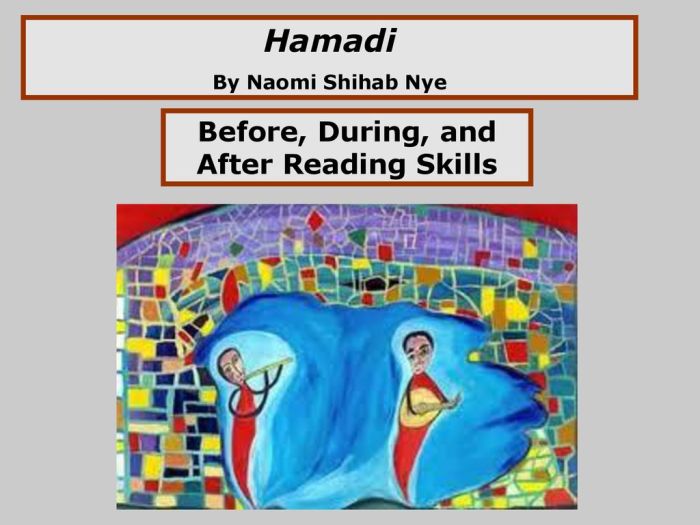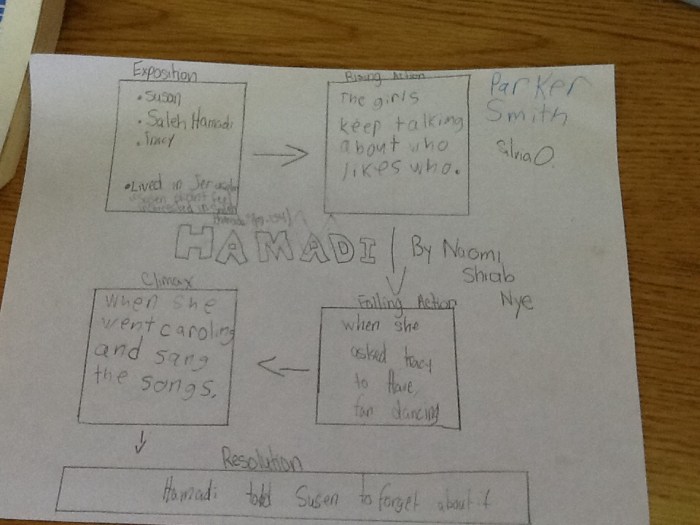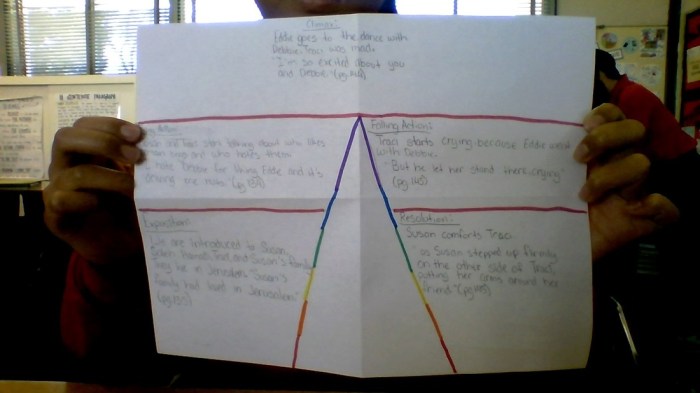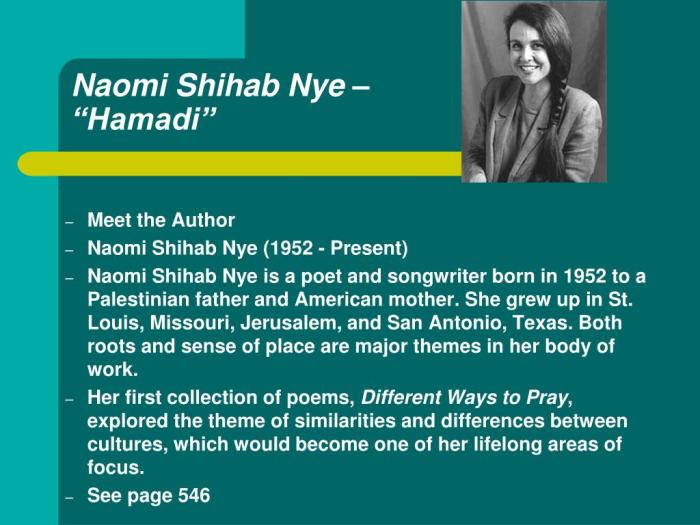Hamadi by naomi shihab nye – In Naomi Shihab Nye’s poignant poem, “Hamadi,” the complexities of identity, loss, and memory intertwine against the backdrop of the immigrant experience. Through vivid imagery and evocative language, Nye invites readers to delve into the depths of a life uprooted and rebuilt, navigating the challenges of assimilation and the longing for home.
The poem’s intricate structure and use of symbolism weave a tapestry of emotions, revealing the resilience and vulnerability of those who have crossed borders, both physical and emotional.
Overview of “Hamadi” by Naomi Shihab Nye

“Hamadi” is a poem by Naomi Shihab Nye that explores themes of immigration, displacement, and the search for belonging. The poem is written in free verse and uses vivid imagery and sensory details to create a powerful and moving portrait of a young boy’s experience of leaving his homeland and arriving in a new country.
paragraphThe poem is divided into three sections. The first section introduces Hamadi and describes his journey to America. The second section focuses on Hamadi’s experiences in his new country, including his struggles with language and culture. The third section concludes the poem with a reflection on Hamadi’s journey and his hopes for the future.
Structure and Form
“Hamadi” is written in free verse, which means that it does not follow a regular meter or rhyme scheme. However, the poem does have a clear structure, with each section focusing on a different aspect of Hamadi’s experience. The poem’s free verse form allows Nye to use a variety of language and imagery to create a powerful and moving portrait of Hamadi’s journey.
Use of Language and Imagery
Nye uses vivid imagery and sensory details to create a powerful and moving portrait of Hamadi’s experience. For example, in the first section of the poem, Nye describes Hamadi’s journey to America in terms of the sights, sounds, and smells that he encounters.
Hamadi by Naomi Shihab Nye explores themes of family and loss. The speaker’s father has passed away, and they are left with memories and a sense of longing. However, the speaker also finds comfort in the memories they shared, like the time they went to Steak n Shake and ordered egg burgers.
These memories help the speaker to keep their father close, even though he is no longer physically present.
She writes:
“He saw the Statue of Libertyrising out of the waterlike a dream.”
This vivid imagery helps the reader to imagine Hamadi’s experience and to understand the sense of wonder and hope that he feels as he arrives in his new country.In the second section of the poem, Nye uses sensory details to describe Hamadi’s struggles with language and culture.
She writes:
“He heard the wordsbut they were like waterslipping through his fingers.”
This sensory detail helps the reader to understand the frustration and isolation that Hamadi feels as he tries to adjust to his new life.
Cultural and Historical Context: Hamadi By Naomi Shihab Nye

Naomi Shihab Nye’s poem “Hamadi” is set in the United States during the 1980s, a time of significant immigration from the Middle East and North Africa. The poem explores the experiences of Hamadi, a young Arab immigrant who is struggling to adjust to his new life in America.
Setting
The poem’s setting is a small town in the American Midwest, a place that is both familiar and foreign to Hamadi. The town is described as being “white and clean,” a contrast to the bustling, chaotic streets of Hamadi’s homeland.
The poem also mentions the “American flag waving” in the town square, a symbol of the country that Hamadi has come to call home.
Characters
The main character of the poem is Hamadi, a young Arab immigrant who is struggling to adjust to his new life in America. Hamadi is described as being “shy” and “lonely,” and he often feels like an outsider in his new community.
However, he is also a determined and resourceful young man, and he is slowly beginning to make a new life for himself in America.
The Immigrant Experience
The poem “Hamadi” offers a poignant portrayal of the immigrant experience. Hamadi is a young man who has come to America in search of a better life, but he quickly discovers that the journey is not easy. He faces discrimination and prejudice from some members of his new community, and he often feels like an outsider.
However, Hamadi is also a resilient and determined young man, and he is slowly beginning to make a new life for himself in America.
Themes and Symbolism

In “Hamadi,” Nye explores various themes through the lens of a young boy’s experience. These include the complexities of identity and belonging, the pain of loss and grief, and the enduring power of memory.
The poem is also rich in symbolism, with the sea, the boat, and the color blue serving as evocative metaphors for these themes.
Identity and Belonging
The poem explores the complexities of identity and belonging, particularly in the context of displacement and cultural difference. Hamadi is a young boy who has been separated from his homeland and is struggling to find his place in a new world.
The sea, which is both a source of beauty and danger, becomes a symbol of Hamadi’s own journey. He is both drawn to the sea and afraid of it, reflecting his own feelings of displacement and longing for home.
Loss and Grief
Hamadi has lost his father, and the poem explores the pain and grief that he feels. The boat, which is both a symbol of hope and loss, becomes a powerful metaphor for Hamadi’s journey through grief.
The color blue, which is often associated with sadness and melancholy, is used throughout the poem to convey Hamadi’s sense of loss. The sea, the sky, and Hamadi’s own eyes are all described as blue, creating a sense of pervasive sadness and longing.
The Power of Memory
Despite the pain of loss and the challenges of displacement, Hamadi finds solace in the power of memory. He remembers his father, his homeland, and the stories that have been passed down to him.
These memories become a source of strength and comfort for Hamadi, helping him to navigate the challenges of his new life. The boat, which is both a symbol of loss and hope, also becomes a symbol of the enduring power of memory.
Poetic Devices and Techniques

Naomi Shihab Nye employs a range of literary devices in “Hamadi” to enhance its emotional impact and convey its themes.
Nye’s use of metaphoris particularly striking. The poem’s opening line, “He is a world of sand,” immediately establishes Hamadi’s connection to the desert environment. This metaphor suggests that Hamadi is not merely a person but a microcosm of the vast and unforgiving desert itself.
Simile
Nye also uses simileto create vivid and memorable images. For example, she describes Hamadi’s “eyes like pools of night” and his “hands like ancient trees.” These similes help the reader to visualize Hamadi’s physical appearance and to understand his deep connection to the natural world.
Personification
In addition, Nye employs personificationto give human qualities to nonhuman things. For example, she describes the desert as “breathing” and the sand as “laughing.” These personifications help to create a sense of wonder and mystery, and they suggest that the natural world is alive and responsive to human presence.
Sensory Language and Vivid Imagery
Throughout the poem, Nye uses sensory language and vivid imagery to create a rich and immersive experience for the reader. She appeals to the senses of sight, sound, touch, and smell, creating a multisensory portrait of Hamadi and his environment.
For example, she describes the “scent of cardamom” and the “sound of wind in the palms.” These sensory details help the reader to feel as if they are actually present in the poem’s setting and to experience Hamadi’s world through their own senses.
Overall Meaning and Impact
The use of literary devices such as metaphor, simile, personification, sensory language, and vivid imagery contribute to the poem’s overall meaning and impact. These devices help to create a vivid and memorable portrait of Hamadi and his environment, and they convey the poem’s themes of connection to the natural world, the importance of human relationships, and the power of memory.
Critical Reception and Legacy

Naomi Shihab Nye’s “Hamadi” has received widespread critical acclaim for its poignant portrayal of the refugee experience and its exploration of themes of identity, displacement, and resilience. The poem has been lauded for its evocative imagery, skillful use of language, and profound emotional impact.
Upon its publication in 1995, “Hamadi” quickly garnered recognition for its ability to humanize the often-overlooked stories of refugees. Nye’s sensitive and compassionate treatment of the subject matter resonated with readers and critics alike, leading to the poem’s inclusion in numerous anthologies and textbooks.
Impact on Contemporary Poetry
“Hamadi” has had a significant impact on contemporary poetry, particularly in the areas of refugee literature and poetry of witness. The poem’s success in capturing the complexities of the refugee experience has inspired other poets to explore similar themes in their work, leading to a growing body of literature that gives voice to the voiceless.
Furthermore, “Hamadi” has contributed to the development of a more inclusive and diverse literary landscape. By highlighting the experiences of marginalized communities, the poem challenges traditional notions of American identity and encourages a broader understanding of the human condition.
Continued Relevance and Significance, Hamadi by naomi shihab nye
In today’s world, “Hamadi” remains as relevant and significant as ever. The poem’s themes of displacement, identity, and resilience continue to resonate with audiences grappling with issues of migration, xenophobia, and global conflict.
The poem serves as a powerful reminder of the human toll of displacement and the importance of compassion and empathy in the face of adversity. Its message of hope and resilience continues to inspire readers to work towards a more just and equitable world.
FAQ Insights
What is the main theme of “Hamadi”?
The poem explores the complexities of identity, loss, and memory through the lens of the immigrant experience.
How does Nye use imagery in the poem?
Nye employs vivid and evocative imagery, such as the sea, the boat, and the color blue, to create a rich sensory experience and convey the emotional depth of the poem.
What is the significance of the setting in “Hamadi”?
The poem’s setting, both in the homeland and the new country, plays a crucial role in shaping the characters’ experiences and the themes of identity and belonging.
